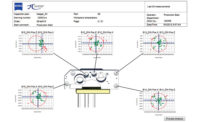AIT Uses Leica Laser Trackers For F-35 aircraft
LAWRENCEVILLE, GA-The Metrology Division of Leica Geosystems (St. Gallen, Switzerland) announces Advanced Integration Technology Inc. (AIT, Plano, TX) has successfully completed the first automated mate cell two weeks in advance for the F-35 Joint Strike Fighter.Three Leica LTD800 laser trackers were instrumental in the laser-guided alignment used to automate and execute F-35 aircraft mating. AIT is an engineering and manufacturing company specializing in the design, fabrication, installation and maintenance of fully integrated plant floor systems.
AIT was contracted by Lockheed Martin to construct a permanent assembly station used for laser-guided alignment and part mating of four F-35 modules. The system uses three Leica laser trackers and 16 servo control positioners to mate the forward to the center fuselage, the wings to the center fuselage, and aft to the wing/center.
Jason McGahey, project manager for AIT, described the first automated mate cell for the JSF program as a team success for all involved, from his AIT department to the Integrated Product Team at Lockheed Martin to the industrial measurement specialists at Leica Geosystems, which supported the effort with training and consulting. The JSF metrology integration into assembly approach delivered a reduction in cost and schedule time because of the flexibility of the process.
McGahey's AIT engineering team wrote a customized interface to integrate the Leica LTD800 with the servo driven jacks and the operator console to create the F-35-JSF Electronic Mate and Alignment System (EMAS). An operator can use the EMAS tool to automatically point the laser tracker and acquire data from targets residing in off-the-shelf nests that have been applied to each aircraft subassembly. The laser tracker will acquire 3-D coordinate target data until the large F-35 modules are adjusted to easily slide into position for connectivity and assembly.
The F-35-JSF EMAS was deemed a technical achievement as the first two aircraft components were loaded, maneuvered into nominal position and the first hole was drilled for joining the components within five days of the completion of the surrounding working platform.


